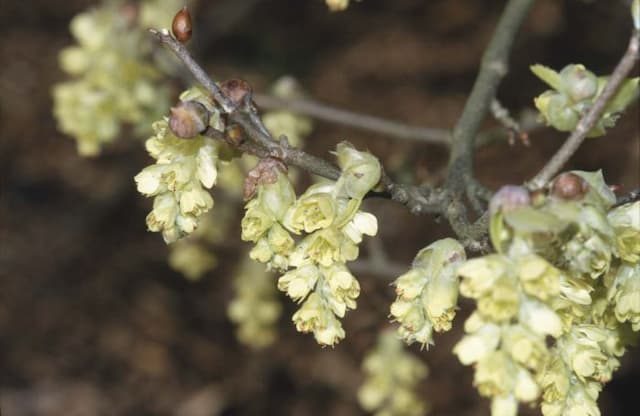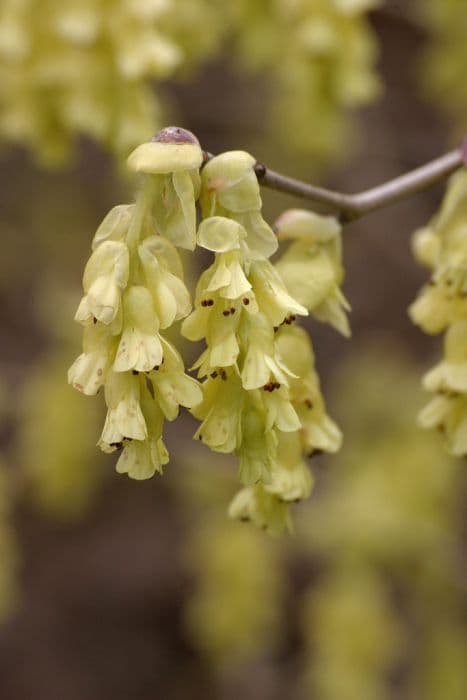Large Witch Alder Fothergilla major Monticola Group

ABOUT
Fothergilla major, belonging to the Monticola Group, is a deciduous shrub known for its attractive multi-season interest. It has a dense, bushy habit with deep green, leathery leaves. The foliage is one of its standout features which takes on a spectacular display of colors in the fall, ranging from brilliant yellows to fiery reds and glowing oranges. This gives the plant a warm and vibrant appearance as the seasons change. In spring, before the leaves unfurl, Fothergilla major produces bottlebrush-like flowers. These flowers are striking and peculiar, consisting of numerous, tiny, white blossoms packed tightly together on spiky inflorescences. Each individual flower has long, filamentous petals that give the entire bloom an airy, feathery appearance. These blooms have a light, honey-sweet fragrance that gently scents the air, attracting pollinators such as bees to the garden. The stems of Fothergilla major are slender and often appear somewhat zigzagged. The bark on mature branches is generally smooth with a grayish-brown tone that contrasts with the brighter green of the younger stems. Overall, Fothergilla major's growth contributes to a rounded, slightly mounded shape, creating a soft and natural silhouette that fits well into a variety of garden settings, from informal cottage gardens to more structured landscape designs.
About this plant
 Names
NamesFamily
Hamamelidaceae
Synonyms
Large Witch Alder, Mountain Witch Alder
Common names
Fothergilla major.
 Toxicity
ToxicityTo humans
There is limited or no information on the toxicity of the Witch Alder (Fothergilla major) to humans. Most sources do not report it as a commonly recognized poisonous plant. In the absence of specific toxicity data, it would be prudent to avoid ingestion and to handle the plant with care, as general caution with all plants. If any part of the plant were mistakenly ingested and symptoms occur, medical attention should be sought.
To pets
Similar to the information for humans, there is limited or no information on the toxicity of Witch Alder to pets. It is not commonly listed as a toxic plant to animals. However, as with humans, it is wise to prevent pets from ingesting parts of this plant. If your pet does consume any part of the Witch Alder and displays signs of distress or illness, contact your veterinarian promptly.
 Characteristics
CharacteristicsLife cycle
Perennials
Foliage type
Deciduous
Color of leaves
Varies
Flower color
White
Height
6-10 feet (1.8-3 meters)
Spread
6-10 feet (1.8-3 meters)
Plant type
Shrub
Hardiness zones
5
Native area
Southeastern United States
Benefits
 General Benefits
General Benefits- Attractive Flowers: Produces beautiful white, brush-like flowers, which add aesthetic value to gardens during their blooming season.
- Seasonal Interest: Offers multi-season interest with spring flowers, summer foliage, and vibrant fall colors. ⟨li>Compact Size: Suitable for small gardens due to its compact growth habit, making it a versatile landscaping choice. ⟨li>Low Maintenance: Requires minimal pruning and care once established, which is ideal for low-maintenance landscapes. ⟨li>Tolerates Variety of Soils: Adaptable to a range of soil conditions, though it prefers acidic, well-drained soils. ⟨li>Attracts Wildlife: Flowers can attract pollinators like bees, while the plant itself can provide shelter for various bird species. ⟨li>Drought Tolerance: Once established, it has a good level of drought tolerance, making it suitable for regions with water restrictions. ⟨li>Pest Resistance: Generally resistant to pests and diseases, minimizing the need for chemical treatments. ⟨li>Easy Propagation: Can be easily propagated from cuttings, allowing gardeners to produce more plants economically. ⟨li>Native Plant: As a plant native to southeastern United States, it supports local ecosystems and biodiversity.
 Medical Properties
Medical PropertiesThis plant is not used for medical purposes.
 Air-purifying Qualities
Air-purifying QualitiesThis plant is not specifically known for air purifying qualities.
 Other Uses
Other Uses- Photography Attraction: Fothergilla's bottlebrush-like blooms and vivid fall colors make it a popular choice for garden photographers and plant enthusiasts looking to enhance their portfolios.
- Theme Gardens: With its distinctive flowers and foliage, Fothergilla can be used to create a specific garden theme, such as a colonial-era garden or a native woodland garden.
- Educational Tool: Horticulture and botany programs often use Fothergilla in their curriculum to teach about pollination, native plants, and seasonal changes in flora.
- Beekeeping Support: The early nectar and pollen provided by Fothergilla flowers are valuable for feeding bees in spring when other food sources may still be scarce.
- Floral Arrangements: Fothergilla branches, with their unique flowers or autumn leaves, are used as striking elements in floral arrangements and bouquets.
- Craft Projects: Dried Fothergilla branches and seed heads can be used in crafting, such as wreath-making or as a natural decor in mixed media art projects.
- Seasonal Festivals: Fothergilla's outstanding fall foliage can be showcased during autumn festivals or garden tours that celebrate the changing seasons.
- Erosion Control: Because it's a shrub that can form dense thickets, Fothergilla is sometimes used on slopes or other erosion-prone areas to help stabilize the soil.
- Wildlife Habitat: The dense foliage provides shelter for small wildlife, while the seeds and insects that visit the flowers offer food to birds and mammals.
- Culinary Presentation: Although not intended for consumption, the unique leaves of Fothergilla can be used as a decorative backdrop or garnish on culinary dishes in high-end cuisine.
Interesting Facts
 Feng Shui
Feng ShuiThe Fothergilla is not used in Feng Shui practice.
 Zodiac Sign Compitability
Zodiac Sign CompitabilityThe Fothergilla is not used in astrology practice.
 Plant Symbolism
Plant Symbolism- Resilience: Fothergilla major, commonly known as witch alder, is often considered symbolic of resilience because it can withstand a variety of soil conditions and is resistant to many diseases.
- Natural Beauty: The witch alder is admired for its natural beauty, with its striking white, bottle-brush-like flowers and gorgeous fall foliage, representing appreciation for the natural aesthetics.
- Adaptability: The plant's ability to adapt to different light conditions is seen as a sign of adaptability, teaching us the importance of flexibility and adjusting to different life situations.
- Purity: Its white flowers are often seen as a symbol of purity and innocence, reflecting clear intentions and honesty.
- Transition: With its characteristic seasonal changes in leaf color, witch alder represents transition and change, reminding us of the constant flow and evolution in life.
 Water
WaterWhen caring for a Mountain Witch Alder, it’s important to maintain consistently moist soil without overwatering. Check the soil moisture weekly, especially during dry spells, and water when the top inch feels dry to the touch. Aim to provide about 1-2 gallons of water weekly during the active growing season, reducing the amount as the plant goes dormant in the fall. Avoid letting the soil become saturated or bone dry as both can stress the plant.
 Light
LightMountain Witch Alder thrives best in full sun to partial shade. The ideal planting spot would get morning sunlight with some afternoon shade, or dappled sunlight throughout the day. Avoid deep shade as it will reduce flowering and foliage vibrancy.
 Temperature
TemperatureMountain Witch Alders are hardy and can tolerate a range of temperatures, withstanding minimums of around 5°F and maximums not exceeding 95°F. This plant performs best in the moderate temperatures of spring and fall, which favorably influence their flowering and fall foliage. The ideal temperature range for Mountain Witch Alder is between 60°F and 75°F.
 Pruning
PruningPruning Mountain Witch Alder is essential for maintaining shape and promoting healthy growth. The best time to prune is in the late winter or early spring before new growth begins. Thinning out dense branches yearly encourages better air circulation and light penetration. Every few years, you may also need to remove any damaged or dead wood to preserve the plant's vitality.
 Cleaning
CleaningAs needed
 Soil
SoilThe best soil mix for Large Fothergilla (Fothergilla major Monticola Group) consists of acidic, well-draining soil rich in organic matter. It thrives in soil with a pH between 5.0 and 6.5. A mix of peat, compost, and bark or pine needle mulch can help maintain the acidity and moisture the plant prefers.
 Repotting
RepottingLarge Fothergilla typically does not need frequent repotting as it is a slow-growing shrub. It should be repotted only if it has outgrown its current space or the soil has degraded significantly, which may be every 3-5 years.
 Humidity & Misting
Humidity & MistingLarge Fothergilla does well in average garden humidity levels and does not require any special humidity considerations. It can tolerate the natural outdoor humidity fluctuations through the seasons.
 Suitable locations
Suitable locationsIndoor
Provide bright indirect light and keep the soil moderately moist.
Outdoor
Plant in partial shade, acid soil, mulch well, and water regularly.
Hardiness zone
5-8 USDA
 Life cycle
Life cycleFothergilla major, commonly known as large witch alder, begins its life cycle as a seed, which after a period of dormancy typically requiring a cold stratification process, germinates in spring. The seedling emerges and develops into a young plant, producing a rosette of leaves and establishing a root system. As the plant matures, it develops woody stems and foliage, and in the spring, it produces distinctive, brush-like flowers before the leaves appear. Pollination occurs through wind or insect activity, leading to the development of seed capsules by late summer or fall. These capsules eventually release seeds to complete the cycle. Throughout its life, large witch alder undergoes annual cycles of dormancy in winter and active growth in the warmer months, with proper care it can live for many years, slowly expanding its clump-forming habit.
 Propogation
PropogationPropogation time
Spring to early summer
The Fothergilla major, commonly known as large witch alder, is typically propagated by softwood cuttings. This is often done in late spring or early summer when growth is new and green but before it has fully hardened. Cuttings about 4 to 6 inches (10 to 15 centimeters) in length are taken from the current year’s growth. These cuttings should include a couple of leaves and are dipped in rooting hormone to increase the chances of successful rooting. The cuttings are then inserted into a well-draining, sterile potting mixture. A high-humidity environment is maintained around the cuttings, often with the use of a plastic cover, until roots have developed, which generally takes several weeks. This method is popular as it maintains the cultivar’s desirable characteristics.









